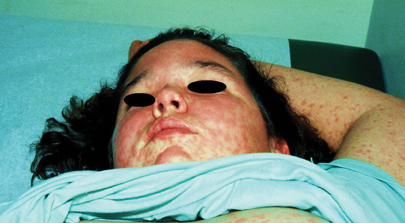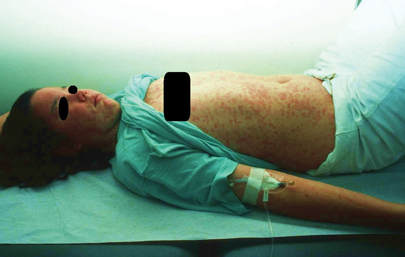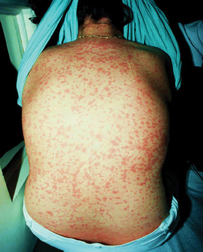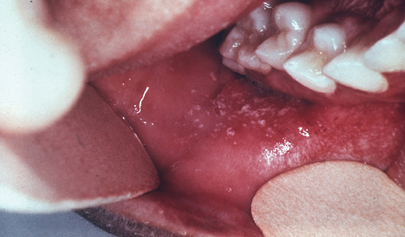A relevant case from 1989: A 12-year-old presents with fever and rash

A 12-year-old female presented to a local ER with a 5-day history of progressively worsening fever, cough, nasal congestion and conjunctivitis, and a 1-day history of a rash, mostly on her face and head. She denied nausea, vomiting, diarrhea, joint pain, sore throat or any other complaints. There had been no known sick contacts at home, school or anywhere else. The only travel was a family vacation to Rocky Mountain National Park, Colorado, 1 month earlier. Her immunizations were up to date (in 1989), and none had been given recently. She had not been taking any medications prior to the onset of the chief complaint.

At the local ER, she was diagnosed with a viral syndrome and given symptomatic treatment. However, the next day, the fever was higher, and the rash had spread to the trunk and extremities. She now presents to your clinic for evaluation.
Examination reveals a fever of 104°F, nasal congestion (coryza), conjunctival erythema (Figure 1) with slight exudate (conjunctivitis), occasional cough with clear breath sounds, and a maculopapular rash (Figures 2 to 5). The rash is more confluent on the face, with more discrete lesions on the rest of the body. The rest of the exam is unremarkable; specifically, there is no other mucous membrane inflammation (except the eyes) and no lymphadenopathy or hepatosplenomegaly.
Lab tests included a CBC, urinalysis, rapid strep test of the throat and a chest radiograph, all of which are negative or normal.




What’s your diagnosis?
A. Rubeola (first disease)
B. Streptococcal scarlet fever (second disease)
C. Rubella (third disease)
D. Filatov-Dukes disease (fourth disease)


Case Discussion
This is a case of measles (choice A) from the 1989 epidemic that ultimately led to the addition of the second dose of MMR to the immunization schedule. It was found that only about 95% of those immunized at 12 to 15 months of age had an antibody response. Adding the second dose, which can be given as soon as 28 days after the first, will increase the immune response to over 99%.
I saw this patient when I was stationed at Brooke Army Medical Center in San Antonio, Texas, along with numerous other cases during that outbreak. As noted in the case description, the maculopapular rash begins on the head and face (Figure 6), around day 3 or 4 of progressive fever, then spreads to the trunk and extremities. Early in the course, one might see Koplik spots — a distinctive, pathognomonic enanthem described by Henry Koplik in 1896 as appearing similar to grains of salt on an erythematous base, usually in the buccal mucosa (Figure 7). Cough, coryza and conjunctivitis (the 3 Cs) are also characteristic. Complications can be as minor as otitis media and as severe as encephalitis, with brain injury, pneumonia and death. Treatment is supportive, along with two doses of supplemental vitamin A (see your Red Book for doses).
This is the most contagious disease known. As such, patients sick enough to require hospitalization should be placed in airborne isolation (a negative-pressure room, gown, gloves and mask with eye protection), until at least 4 days after the onset of the rash.
The outbreak from 1989 through 1991 resulted in over 55,000 cases, with more than 11,000 hospitalizations and 123 deaths. This case was originally published in the October 1989 edition of this column, in which I wrote a long discussion of measles and provided other choices, which then also included the fifth and sixth diseases as well. However, at this current time in history, measles deserves all the space we can give it.
- For more information:
- James H. Brien, DO, is with the department of infectious diseases at McLane Children’s Hospital, Baylor Scott & White Health, Texas A&M College of Medicine in Temple, Texas. He also is a member of the Infectious Diseases in Children Editorial Board. Brien can be reached at jhbrien@aol.com.
Disclosure: Brien reports no relevant financial disclosures.
Columnist comments: Some of you may recall that in years past, I usually ended my columns with a brief commentary that seemed relevant at the time, often regarding our uniformed pediatric providers in war zones or other noteworthy issues. This “comments” feature has given way to the new, sleek style, with less in print and more online. However, with this issue of IDC, I feel compelled to voice a concern over the disturbing trend of well-intentioned but misguided parents who choose to not immunize their children. Measles may be in the headlines now, but without a change in this trend, rest assured that in time other vaccine-preventable diseases will rear their ugly heads as well.
As noted in the famous aphorism by George Santayana, “those who cannot remember the past are condemned to repeat it”; only parents with no knowledge of diseases such as tetanus, diphtheria, measles, polio, smallpox, Haemophilus influenzae type b meningitis, pertussis and others, would find immunizations as the evil plague on their children that they think it is.
I doubt many of us have a working understanding of aeronautical engineering, yet we get on a plane to fly, trusting that the scientist engineers who designed the plane knew what they were doing, even after an occasional mistake is made. My mother did not have a high school education, and certainly did not understand the science behind vaccine development, but she understood first-hand the diseases caused by tetanus, polio and smallpox, and she trusted the scientists who developed the vaccines against those diseases enough to get me and my brothers immunized against them all (thankfully).
With that in mind, I stand in awe of those who have led the charge to educate the public; physician scientists such as Larry Pickering, Paul Offit, Peter Hotez and others at the national level, often at the risk of personal threats. There are many other vaccine champions at the local level as well, and although it is often tempting to just give up and let nature take its course, we should all give our support to this campaign to educate parents and others of the solid science behind vaccine recommendations any way we can. We are all in this together.
